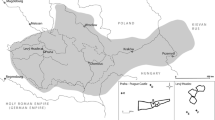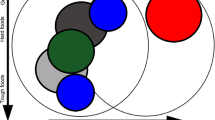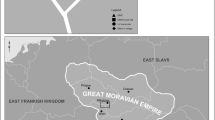Abstract
Seasonal variance in the diet of Ache hunter-gatherers is examined. Fluctuation in the number of calories of honey consumed daily contributed most to the differences in total calories consumed daily during different seasons of the year. Meat, the most important resource in the diet, provided the greatest number of calories daily, and varied little across seasons. The vegetable component of the diet is characterized by low variance in absolute numbers of calories, but high variance in species composition. The mean number of calories consumed daily per capita is high (3827 calories) compared to that reported for other hunter-gathers. Differences in energy expenditure and consumption among modern hunter-gatherers is discussed.
Similar content being viewed by others
References
Abruzzi, W. S. (1980). Flux among the Mbuti Pygmies of the Ituri Forest: An ecological interpretation. In Ross, E. (ed.),Beyond the Myths of Culture. Academic Press, New York.
Adams, C. F. (1975).Nutritive Value of American Foods in Common Units. Agriculture Handbook 456, U.S. Department of Agriculture.
Bertoni, M. (1941). Los Guayakies.Revista de la Sociedad Cientifica del Paraguay 2: 2–62.
Binford, L. (1980). Willow smoke and dog's tails.American Antiquity 45: 4–20.
Blurton Jones, N. (1983). A selfish origin for human food sharing: Tolerated theft.Ethology and Sociobiology 4: 145–147.
Blurton Jones, N., and Sibly, R. M. (1978). Testing adaptiveness of culturally determined behavior: Do Bushman women maximize their reproductive success by spacing births widely and foraging seldom? In Reynolds, V., and Blurton Jones, N. (eds.),Human Behavior and Adaptation. Society for Study of Human Biology Symposium #18. Teller and Francie, London.
Bowdler, S. (1981). Hunters in the highlands: Aboriginal adaptation in the Eastern Australian Uplands.Archeology in Oceania 16(2): 99–111.
Cadogan, L. (1973). Tangy Puku. Centros de Estudios Antropologicos Universidad Catolica “Nuestra Senora de la Asuncion.” Asuncion del Paraguay.
Damas, D. (1972). The copper Eskimo. In Bicchieri, M. G. (ed.),Hunters and Gatherers Today. Holt, Rinehart, and Winston, New York.
Downs, J. (1966).The Two Worlds of the Washoe. Holt, Rinehart, and Winston, New York.
Durnin, J. V. G. A., Edholm, O. G., Miller, D. S., and Waterlow, J. C. (1973). How much food does man require?Nature 242: 418.
Ember, C. (1978). Myths about hunter-gatherers.Ethnology 17(4): 439–448.
Foster, R. B. (1973).Seasonality of Fruit Production and Seed Fall in a Tropical Forest Ecosystem in Panama. Ph.D. dissertation, Duke University, Durham, North Carolina.
Gould, R. A. (1977).Puntutjarpa Rockshelter and the Australian Desert Culture Vol. 54, Part 1). Anthropological Papers of the American Museum of Natural History, New York.
Harris, D. (1980).Human Ecology in Savannah Environments. Academic Press, London.
Hart, J. A. (1978). From subsistence to market: A case study of the Mbuti net hunters.Human Ecology 6: 325–353.
Hawkes, K., Hill, K., and O'Connell, J. (1982). Why hunters gather: Optimal foraging and the Ache of Eastern Paraguay.American Ethnologist 9: 379–398.
Hill, K. (1983).Adult Male Subsistence Strategies among Ache Hunter-Gatherers of Paraguay. Unpublished Ph.D. thesis, University of Utah.
Hill, K., and Hawkes, K. (1983). Neotropical hunting among the Ache of Eastern Paraguay. In Hames, R., and Vickers, W. (eds.),Adaptive Responses of Native Amazonians. Academic Press, New York.
Hoebel, E. A. (1978).The Cheyennes: Indians of the Great Plains. Holt, Rinehart and Winston, New York.
Hurtado, A. M., Hill, K., Kaplan, H., and Hawkes, K. Womens time allocation to activities among Ache hunter-gatherers of Paraguay. Department of anthropology, University of Utah, unpublished manuscript.
Jones, R. (1980). Hunters in the Australian coastal savanah. In Harris, D. (ed.),Human Ecology in Savannah Environments. Academic Press, London.
Kaplan, H., Hill, K., Hawkes, K., and Hurtado, A. M. (1984). Food sharing among Ache huntergatherers of eastern Paraguay.Current Anthropology 25: 113–115.
Ledger, H. P. (1968). Body composition as a basis for comparitive study of some East African mammals.Symposia of the Zoological Society of London 21: 289–310.
Lee, R. B. (1979).The !Kung San. Cambridge University Press, New York.
Leigh, E. G., Rand, A. S., and Windsor, D. M. (eds.). (1983).The Ecology of a Tropical Forest: Seasonal Rhythms and Long-Term Changes. Smithsonian Press, Washington.
Leung, W-T. W. (1961).Food Composition Table for Use in Latin America. National Institutes of Health, Bethesda, Maryland.
Lizot, J. (1978). Population, resources, and warfare among the Yanomami.Man 12: 497–517.
Meehan, B. (1975).Shell Bed to Shell Midden. Ph.D. thesis, Australian National University, Canberra.
Montgomery, E., and Johnson, A. (1977). Machiguenga energy expenditure.Ecology of Food and Nutrition 6: 97–105.
Pitts, G. C., and Bullard, T. R. (1968). Some interspecific aspects of body composition in mammals.National Academy of Sciences Publication 1598: 45–70.
Opler, P. A., Frankie, G. W., and Baker, H. G. (1976). Rainfall as a factor in the release, and anthesis by tropical trees and shrubs.Journal of Biogeography 3: 231–236.
Schaller, G. (1972).The Serengeti Lion. Chicago: The University of Chicago Press.
Shepard, R. J., and Godin, G. (1976). Energy balance of an Eskimo community. In Shepard, R. J., and Itoh, S. (eds.),Circumpolar Health. University of Toronto Press, Toronto.
Speth, J. D., and Spielmann, K. A. (1983). Energy source, protein metabolism, and huntergatherer subsistence strategies.Journal of Anthropological Archeology 2: 1–31.
Steward, J. H. (1938). Basin-plateau aboriginal sociopolitical groups.Smithsonian Institution Bureau of American Ethnology Bulletin, 120.
Tanaka, J. (1980).The San Hunter-Gathers of the Kalahari: A Study in Ecological Anthropology. University of Tokyo Press, Tokoyo.
Taylor, C., and Pye, O. (1966).The Foundations of Nutrition. Macmillan, New York.
Thompson, D. (1939). The seasonal factor in human culture, illustrated from the life of a contemporary nomadic group.Proceedings of the Prehistoric Society 5: 209–221.
Truswell, A. S., and Hansen, J. D. L. (1976). Medical research among the !Kung. In Lee, R. B., and DeVore, I. (eds.),Kalahari Hunter-Gatherers. Harvard University Press, Cambridge.
Watanabe, H. (1968). Subsistence and ecology of northern food gatherers with special references to the Ainu. In Lee, R. B., and DeVore, I. (eds.),Man the Hunter. Aldine, Chicago.
Watt, B. K., Merrill, A. L., Orr, M., and Wu, W-T. (1950).Composition of Foods-Raw,Processed, and Prepared. Agriculture Handbook 8, U.S. Department of Agriculture.
White, R. T., and Stallings, J. R. Claves para la identification de los Mamiferos del Paraguay. Unpublished manuscript.
Wilmsen, E. N. (1982). Studies in diet, nutrition, and fertility among a group of Kalahari bushman in Botswana.Social Science Information 21: 5–125.
Yellen, J. (1976). Settlement patterns of the !Kung: An ecological perspective. In Lee, R. B., and DeVore, I. (eds.), Kalahari Hunter-Gatherers. Harvard University Press, Cambridge.
Yesner, D. (1980). Maritime hunter-gatherers: Ecology and prehistory.Current Anthropology 21: 726–750.
Author information
Authors and Affiliations
Rights and permissions
About this article
Cite this article
Hill, K., Hawkes, K., Hurtado, M. et al. Seasonal variance in the diet of Ache hunter-gatherers in Eastern Paraguay. Hum Ecol 12, 101–135 (1984). https://doi.org/10.1007/BF01531269
Issue Date:
DOI: https://doi.org/10.1007/BF01531269




